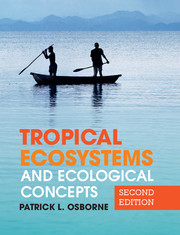Book contents
- Frontmatter
- Contents
- Preface
- Abbreviations and units
- Chapter 1 The tropical environment and climate
- Chapter 2 Dry, hot deserts and environmental factors
- Chapter 3 Grasslands and primary production
- Chapter 4 Savanna and population dynamics
- Chapter 5 Lakes, energy flow and biogeochemical cycling
- Chapter 6 Rivers, floodplains and estuaries
- Chapter 7 Wetlands and succession
- Chapter 8 Tropical rain forests and biodiversity
- Chapter 9 Mountains, zonation and community gradients
- Chapter 10 Mangroves, seagrasses and decomposition
- Chapter 11 Coral reefs and community ecology
- Chapter 12 Islands, archipelagos, biogeography and evolutionary ecology
- Chapter 13 Cities and human ecology
- Glossary
- References
- Index
- References
Chapter 1 - The tropical environment and climate
Published online by Cambridge University Press: 05 June 2012
- Frontmatter
- Contents
- Preface
- Abbreviations and units
- Chapter 1 The tropical environment and climate
- Chapter 2 Dry, hot deserts and environmental factors
- Chapter 3 Grasslands and primary production
- Chapter 4 Savanna and population dynamics
- Chapter 5 Lakes, energy flow and biogeochemical cycling
- Chapter 6 Rivers, floodplains and estuaries
- Chapter 7 Wetlands and succession
- Chapter 8 Tropical rain forests and biodiversity
- Chapter 9 Mountains, zonation and community gradients
- Chapter 10 Mangroves, seagrasses and decomposition
- Chapter 11 Coral reefs and community ecology
- Chapter 12 Islands, archipelagos, biogeography and evolutionary ecology
- Chapter 13 Cities and human ecology
- Glossary
- References
- Index
- References
Summary
Alphonse de Candolle in 1855 proposed that the boundaries to major plant formations were set by climate. He suggested that the limits to deserts and grasslands were set by moisture, but that the latitudinal arrangement of the other plant formations indicated temperature as the dominant factor. Köppen (1884, 1931) developed climate maps based on vegetation types. In this way, he was able to produce a climate map of the world even though he had very little climatic data from many parts of it. He assigned to each plant formation the climate that seemed appropriate to it. Since his climate map was based on the global distribution of vegetation types, it is not surprising that climate and vegetation maps were similar. It has subsequently been shown that the distribution of the world’s climatic regions is indeed closely related to vegetation and Köppen’s vegetation-derived climate map has now been verified through climatic measurements. Clearly climate plays a major role in determining the global distribution of plants and animals and Figures 1.1 and 1.2 show the close relationship between rainfall and vegetation in Africa.
This chapter describes climate in the tropics and how it differs from that found in temperate regions. It describes how the world’s climate is changing through an enhancement of the greenhouse effect (global warming), and how this climate change is impacting tropical ecosystems. Variations in climate regime and soil type mainly determine the regional distribution of vegetation types and, hence, animal communities, and these patterns are studied by biogeographers. An explanation of these plant and animal distributions also requires an understanding of the theory of plate tectonics.
- Type
- Chapter
- Information
- Tropical Ecosystems and Ecological Concepts , pp. 1 - 25Publisher: Cambridge University PressPrint publication year: 2012



